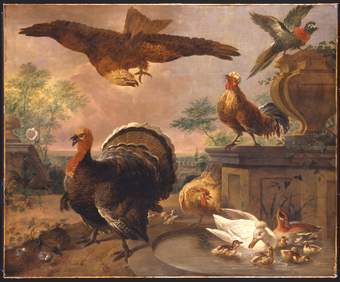
Fig.1
Jan Griffier the Elder 1646 or 52 – 1718
Turkey and other Fowl in a Park 1710
Oil paint on canvas
1146 × 1390 mm
T04129
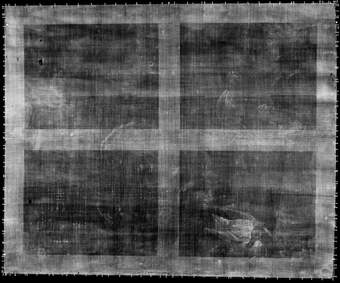
Fig.2
X-radiograph of Turkey and other Fowl in a Park
This painting is in oil paint on linen canvas measuring 1140 x 1388 mm (fig.1). The canvas is plain woven from coarse thread with many slubs; per square centimetre there are approximately 14 vertical threads and 8 horizontal (fig.2). The original tacking edges have been removed but cusping on all four edges indicates that little or none of the original design has been lost.1 The cusping is pronounced at the top, bottom and right edges but only faint at the left, suggesting that the canvas was cut from a pre-primed roll. A long age crack at each side of the painting, 50 mm in from the right and left edges, perhaps indicates the width of the original stretcher bars, although there are no equivalent cracks at the top and bottom edges. The painting is lined with glue-paste adhesive onto a finely woven canvas, which is attached with iron tacks to an adjustable pine stretcher; both lining canvas and stretcher appear to date from the early twentieth century.
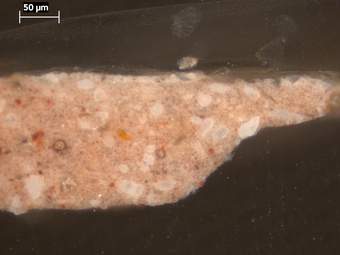
Fig.3
Cross-section from the sky at the top, left corner, 128mm from the top edge and 54mm from the left, photographed at x320 magnification. From the bottom: two coats of opaque, mushroom-pink ground, probably with a coat of animal-glue size between them; opaque pale blue paint of sky, on average 10 microns thick; varnish.
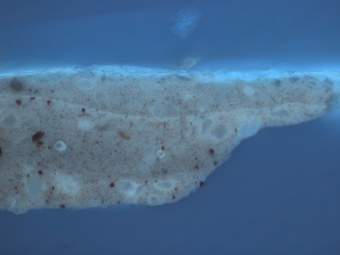
Fig.4
The same cross-section as in fig.3, photographed in ultraviolet light
The ground is an opaque, pinkish mushroom colour, applied in two coats (figs.3–4). It is probably bound in oil and is composed of lead white, red ochre, sienna, fine black, chalk, glassy particles and a little pipeclay filler. Inspection of cross-sections in ultraviolet light suggests the presence of an interlayer of animal glue size between the two coats, though this was not confirmed by staining for proteins with acid fuchsin. The ground is in good condition.
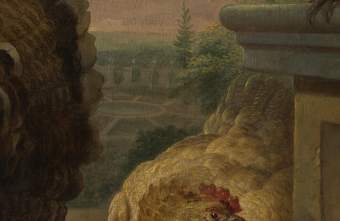
Fig.5
Detail of the plinth, hen, landscape background and turkey’s tail. The horizontal shadows of the plinth are the initial brown paint used to establish certain areas of the composition.
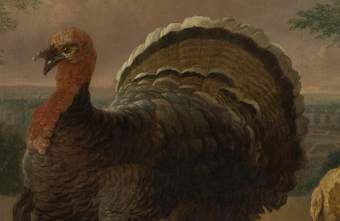
Fig.6
Detail of the turkey, showing the head and shoulders painted on top of the sky but with a reserve left in the landscape and foreground for the lower body

Fig.7
Larger detail of fig.6
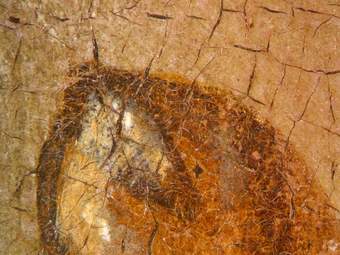
Fig.8
Detail at x8 magnification showing no reserve for the duckling's beak in front of the red duck
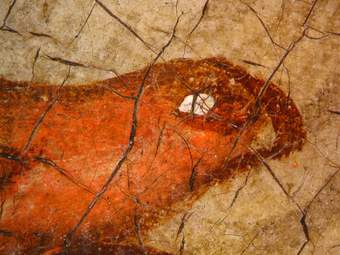
Fig.9
Detail at x8 magnification of the reserve for a duckling's beak in front of the white duck's chest
No underdrawing was detectable in infrared reflectography nor in visible light. Instead close inspection of the painting suggests that some parts of the design were established with thin brown paint, which was left visible here and there to act as shadows (fig.5). The compositional process appears to have been flexible. It would appear that the sky was painted first with a reserve for the urn but without significant reserves for the other features that are silhouetted against it. This may be seen in figs.6–7, showing the brushy sky paint visible here and there under the turkey’s head and upper body. By contrast, a reserve was left in landscape and foreground paint for the rest of his body, except for the legs, which were added on top of foreground paint. Some reserves were left in the adult ducks for the ducklings, for example in the white duck for the beak of the left-hand duckling; but no reserve was left for the duckling in front of the red duck (figs.8–9). There is little formal underpainting, apart from the blue flowers, where the ultramarine paint that is visible to us is underpainted with pale opaque grey; this is composed of lead white and smalt, and it is possible that the smalt has faded from its original pale blue.
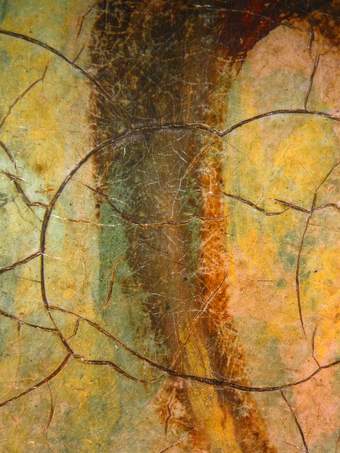
Fig.10
Detail at x8 magnification of the cockerel’s leg
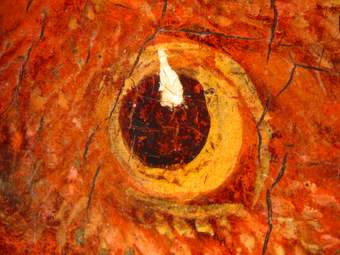
Fig.11
Detail at x8 magnification of the cockerel’s eye
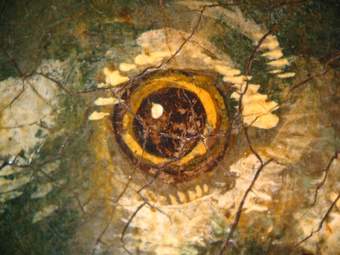
Fig.12
Detail at x8 magnification of the parrot’s eye
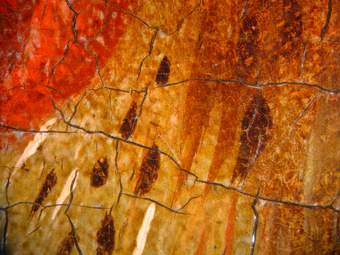
Fig.13
Detail at x8 magnification of the cockerel’s plumage
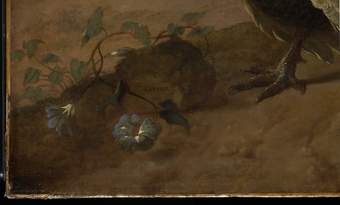
Fig.14
The signature in the lower left corner:
‘John . GRIFFIER / 1710’
The artist’s palette consists of a broad range of highly coloured, good quality pigments including: verdigris, ultramarine, smalt, blue verditer, orpiment, yellow ochre, yellow lake, Naples yellow, vermilion, red lake, black, sienna, Cologne earth and lead white.2 These were deliberately chosen for certain paint passages: ultramarine for the bright blue flowers; blue verditer for the greenish blue on the parrot’s wing; vermilion for the turkey’s head. Most colours were made of fairly complex mixtures of pigments and many also contain smalt or glassy particles as translucent extenders. The rather bluish green leaves at the lower left corner (fig.14) may appear so because colour has been lost from yellow lake combined or glazed over a with a blue pigment to create a mixed green.
August 2020
